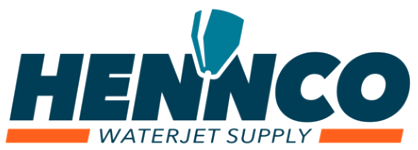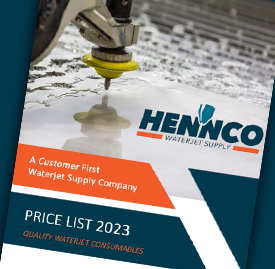
How Long should my High Pressure Seals last on my Pump?
Seal Life--one of the most common questions we field and one of the most difficult to answer. Like most things in waterjet there are many factors which can affect the output. To better understand what a customer should be getting for seal life, we ask a series of question that hopefully will provide us with a range. Questions include: water quality & water treatment, operating pressure, orifice & nozzle combination, number of cycles, age of equipment and standard maintenance procedures. All of these inputs provide a base line for us and you to measure your seal life against. If you fall below the base line and would like to work towards improving seal life, we will continue to work with customers to find the root cause through a series of additional questions, tests and observations.
What is the correct procedure for replacing my On/Off Valve Repair Kit?
With High Pressure water relieved from system--turn cutting head to the ON POSITION. Believe it or not many folks miss this important step when maintaining their valve. Turning cutting head to on position sends air to the valve which retracts piston and relieves pressure on needle. Now as you tighten all components, any small misalignment between seat and needle is not turned 360 degrees. Once head is closed, needle and seat will align.
How much abrasive should I be feeding the cutting head?
Over feeding cutting heads with abrasive is a very common issue. With abrasive being the largest single cost in abrasive waterjet cutting, it is important to monitor or measure feed rates as over time most of today's abrasive metering devices will change feed rates due to wear. So how much should you be feeding? Like so many things in waterjet, the answer depends on your situation. Here are few guidelines to consider:
- Pressure: 60K versus 90K
- Orifice Size
- Nozzles Size
- Abrasive Type & Size
- Material Type & Thickness
Most manufacturers provide exact specifications for abrasive feed rates based on system set up. However abrasive feed rates for any given set up on any machine are actually flexible.
Abrasive feed rates are best expressed in a bell curve, meaning there is a range for optimal cutting in the middle with drop offs on either side. This why Hennco promotes an abrasive metering device that can be changed during cutting process to see affects to jet quality.
Why are we not able to cut at system's suggested feed rates?
In waterjet there are four variables that affect cutting outcomes: Pressure, Abrasive, Orifice size and Nozzle size. The system must match all these inputs to have a chance at proper cutting. We typically ask customers to double check each one of these inputs to ensure proper setting.
Nozzle are easiest to check and trouble shoot. Nozzle ID can be checked with a pin gauge set. Exit side of nozzle can be checked visually for roundness--tear drop shapes suggest misaligned orifice. And nozzles can easily be changed to see if a particular nozzle was at fault.
Orifices are second in line and we typically ask customers to perform a simple test to see if orifice is capable of producing cohesive jet stream. Replacement of orifice can also help us understand if particular orifice was issue.
Abrasive Feed Rate is checked by letting abrasive flow for 60 seconds and measuring. Measured feed rates should match system settings.
Pressure is typically checked by looking at High Pressure gauge or reviewing hydraulic pressure and times by 20x (for 60K units) Example 2800 hydraulic reading x 20 = 56,000 output pressure. A key question with pressure is how do we know all the pressure is getting to cutting head? Is there blockage that is preventing full pressure at the head? Blocked pressure manifests with extreme heat. System components can be checked by hand or with a temperature gun.
Another test we ask customers to do is turn on pump with head closed and wait for 60 seconds to see if pump strokes? A system with no leaks will not enable pump to stroke once system is fully filled with HP water. Once system is pressurized, if pump does stroke we have an issue somewhere in the system. Number of strokes may indicate seriousness of leak.

